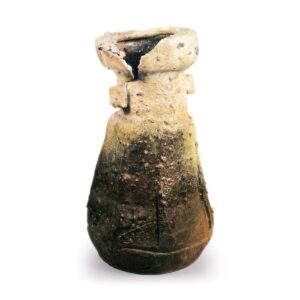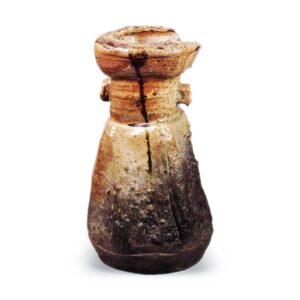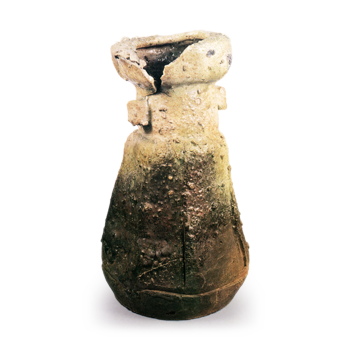

Iga vase with floral motifs and earrings, Karatachi.
Important Cultural Property
Height: 28.4cm, Bore: 8.2cm, Left and Right: 15.0cm, Bottom: 13.0cm
Hatakeyama Memorial Museum
Iga ware is the most highly valued of the Japanese ceramic vases of the Momoyama period. The highly artificial and peculiar shape of the vase, which is generally recognized as Oribe’s favorite, and the terrific burnished surface, which is the result of an outrageously intense flame baptism, are in unusual harmony, and bring about an exceptional beauty that cannot be experienced in works from other kilns. Moreover, when placed in a hermitage tea room with flowers, it creates a more solemn alcove than any flower vase.
This flower vase is a symbol of the exceptional beauty seen in Iga ware. The outward opening of the ro-zukuri is held inward at the mouth end to form a yoseguchi, the neck is tightened to form ears on either side, and the hexagonally beveled body is shaped with a spatula around the hem. The body is hexagonally beveled with a spatula around the hem. During firing, the square part of the body was broken off and lost, and the remaining pieces were scattered on the neck and body. The upper part of the body is covered with ash fall from firewood from the mouth to the body, resulting in a grayish-yellow and partly grass-Ryokuyu surface, while the lower half of the body is burnished dark green and purple-black. This type of ash glaze in Iga is commonly called “beadlo,” but because it is natural yuzu, no yuzu is applied from the base to the bottom, and the brown burnt clay is surprisingly soft and tight. The brownish-brown clay skin is unexpectedly soft and tight. The kinzuke holes on the front and back of the neck have been filled in. It was once in the Maeda family of Kaga.



